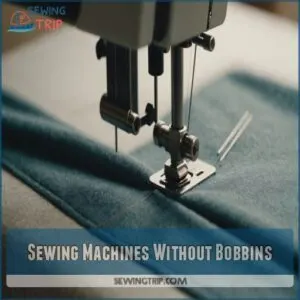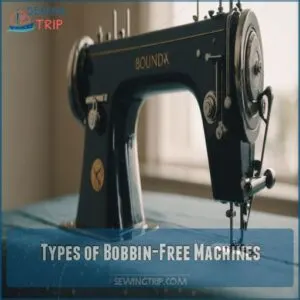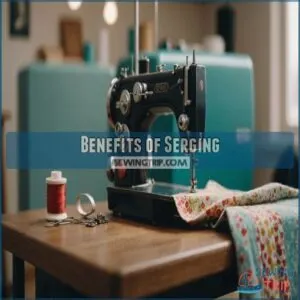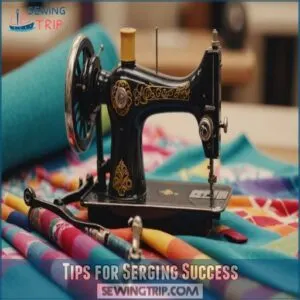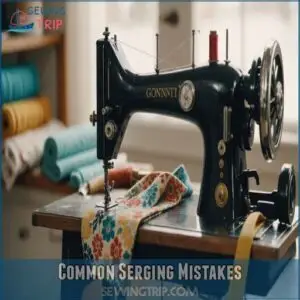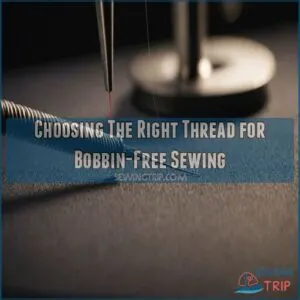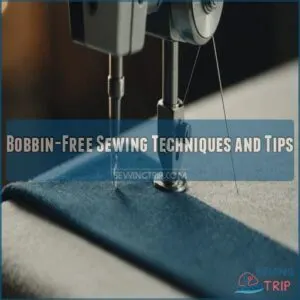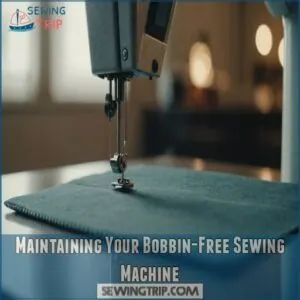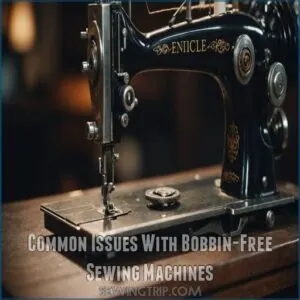This site is supported by our readers. We may earn a commission, at no cost to you, if you purchase through links.
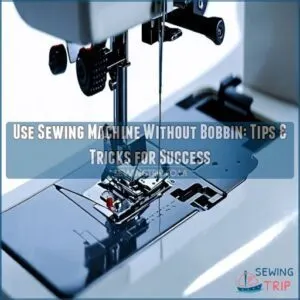 Using a sewing machine without a bobbin can feel like cooking without salt—you’re missing a key ingredient for success.
Using a sewing machine without a bobbin can feel like cooking without salt—you’re missing a key ingredient for success.
Typically, the bobbin thread forms half the stitch, looping with the top thread.
Without it, your stitching will be as effective as a ghost trying to sew.
However, machines like sergers, overlock, or chain stitch don’t use bobbins and can still work wonders on your fabric.
These machines use loopers instead, adding strength and finesse to your sewing.
Curious about conquering the sewing world without a bobbin?
Fear not, because a treasure trove of techniques awaits you!
Table Of Contents
- Key Takeaways
- Sewing Machines Without Bobbins
- Types of Bobbin-Free Machines
- Using a Serger for Bobbin-Free Sewing
- Choosing The Right Thread for Bobbin-Free Sewing
- Bobbin-Free Sewing Techniques and Tips
- Maintaining Your Bobbin-Free Sewing Machine
- Common Issues With Bobbin-Free Sewing Machines
- Frequently Asked Questions (FAQs)
- Conclusion
Key Takeaways
- You can sew without a bobbin using specialized machines like sergers or chain stitch machines.
- Mastering thread tension is crucial for success in bobbin-free sewing, and proper sewing machine preparation like ensuring the foot pedal is firmly connected to the sewing machine is also vital. regardless of the machine used.
- Proper cleaning and maintenance of the bobbin case, including removing lint as discussed in bobbin threading issues, are essential for keeping your bobbin-free sewing machine running smoothly.
- Bobbin-free sewing isn’t suitable for all fabrics or projects; consider the limitations before starting.
Sewing Machines Without Bobbins
If you think sewing machines can’t operate without a bobbin, think again: bobbins are small spools that hold the lower thread in a sewing machine, and understanding how does a sewing machine bobbin work is key to mastering a sewing machine. Specialized machines like sergers and chain stitch machines use creative techniques to stitch seamlessly.
Embrace the freedom of bobbin-free sewing and discover how these machines can simplify your craft while producing a professional finish.
Alternative Sewing Techniques
Exploring sewing without a bobbin? Try out these creative techniques!
- Hand-stitching methods: Channel your inner artisan for intricate details.
- Fabric glue alternatives: Embrace no-sew methods for quick fixes.
- Free-motion quilting: Express your artistic flair on fabric.
- Embroidery techniques: Craft beautiful designs sans a bobbin.
Experiment with these to redefine your sewing world!
Benefits of Bobbin-Free Sewing
After exploring various alternative techniques, you’ll see sewing without a bobbin can revolutionize your projects.
Faster stitching and less thread waste are perks of serger machines and overlockers.
With the help of bobbinless lockstitch sewing, you can manage thread tension differently and enjoy easier repairs and reduced fabric bulk, sparking enhanced creativity.
Bobbin alternatives streamline sewing stitches, giving you more freedom and control, making the sewing process a breeze!
Limitations of Bobbin-Free Sewing
Imagine you’re looking at bobbin-free options, but there are some catches.
1. Fabric types: Tougher fabrics may not handle stitch types well.
2. Thread tension: Without bobbins, setting it right becomes tricky, affecting your sewing embellishments.
3. Cost comparison: Specialized machines can strain the budget.
Understanding these factors helps you gauge the project scope and choose sewing machines wisely.
Types of Bobbin-Free Machines
When you’re ready to explore bobbin-free machines, you’ll find options like overlock, embroidery, and chain stitch machines.
Each type brings unique advantages to your sewing projects, whether you’re finishing seams or crafting intricate designs.
Overlock Machines
So, you’ve mastered sewing without bobbins using other methods.
Now, let’s look at sergers!
These workhorses are perfect for clean finishes.
They’re bobbin-free, using loopers instead.
Here’s a quick comparison of popular serger types:
| Serger Type | Pros | Cons |
|---|---|---|
| Basic Serger | Easy to use, affordable | Fewer features |
| Professional | More features, better quality | Expensive |
| Specialty Serger | Unique features (e.g., coverstitch) | Pricey, specialized projects only |
Remember proper serger maintenance for smooth sewing!
Embroidery Machines
While sergers elegantly finish fabric edges, let’s talk about embroidery machines.
These machines skip the bobbin by crafting intricate designs with just the top thread.
You’ll explore various embroidery machine types, use specific embroidery design software, and choose the right embroidery hoop sizes.
Don’t forget about embroidery thread types and regular embroidery machine maintenance to keep things running smoothly!
Chain Stitch Machines
Embroidery machines might catch your eye, but when you’re looking at chain stitch machines, you’re discovering something unique.
These machines use a single thread, creating a robust chain-like stitch.
Perfect for decorative sewing projects, they tackle bobbin tension issues head-on.
For those interested in models without traditional bobbins, consider checking out specialized products on a bobbinless sewing machine website.
Maintenance is key; keep them clean for best results.
Compared to sergers, chain stitch machines offer specific stitching advantages.
Using a Serger for Bobbin-Free Sewing
Using a serger lets you skip the bobbin while achieving professional, clean seams and edges on your fabric projects.
Unlike traditional machines, it uses loopers to create sturdy stitches, saving you from bobbin migraines and ensuring a polished finish every time.
Benefits of Serging
A serger’s versatility is your ticket to seamless sewing without the bobbin fuss.
Imagine skipping bobbin system complexity!
Here’s why serging stands out:
- Edge Finishing: Achieve professional, fray-free edges on various fabric types.
- Seam Creation: Perfectly crafted seams enhance durability.
- Decorative Edging: Add flair with decorative stitching, transforming ordinary into extraordinary.
Say goodbye to metal and plastic bobbins, hello to a smoother sewing journey!
Tips for Serging Success
Mastering serging starts with controlling serger thread tension, which helps prevent those unruly loops.
Keep an eye on serger foot pressure to make sure smooth fabric feeding happens.
To get the most out of your serger, you need to know the benefits of using a serger, especially when working with stretchy fabrics.
Try various serger stitch types for different projects.
Don’t overlook choosing serger needles that suit your fabric types.
Sergers excel with both woven and stretchy fabrics, making them versatile tools in your sewing toolkit.
Common Serging Mistakes
Even with a trusty serger, common mistakes can weave a tangled web of issues like thread tension problems and uneven stitch length. Avoid these pitfalls:
- Thread tension issues: Check settings regularly.
- Uneven stitch length: Adjust feed dogs correctly.
- Fabric bunching: Maintain steady pressure.
- Skipped stitches: Use the right needle.
- Needle problems: Keep spares handy!
Steer clear, and sew smoothly!
Choosing The Right Thread for Bobbin-Free Sewing
Choosing the right thread is essential for bobbin-free sewing success.
The wrong thread can lead to frustrating breakage and uneven stitches.
Let’s explore the best thread types and tension settings for a smooth sewing experience.
Understanding thread properties, like its strength and elasticity, will help you avoid common bobbin-free sewing pitfalls and create professional-looking results.
Types of Thread for Bobbin-Free Sewing
Choosing the right thread for bobbin-free sewing can be like finding the perfect partner for your fabric.
Whether you’re using serger thread, embroidery thread, or chain stitch thread, you need to match thread types with fabric types.
Imagine serger thread dancing harmoniously with stretchy fabrics, while embroidery thread complements intricate designs.
Remember, your fabric’s personality determines its thread soulmate!
Thread Tension and Bobbin-Free Sewing
After selecting the right thread type, you’ll need to focus on thread tension adjustment in bobbin-free sewing.
Serger tension, naturally, varies with fabric type impact.
If the fabric puckers or the stitches are loose, tweak your machine’s settings.
Adjust thread tension control gently—think of it as polite persuasion rather than brute force.
Match tension with your material’s personality for seamless stitching.
Troubleshooting Thread Issues
Now that you’ve tackled tension, let’s focus on thread issues.
Choosing the right thread for bobbin-free sewing can prevent headaches like breakage.
Consider these key factors:
- Fabric type: Match thread to your fabric.
- Thread quality: High-quality threads reduce problems.
- Needle issues: Make sure it’s compatible.
- Tension problems: Adjust for smooth stitching.
These tips can keep your sewing adventure seamless!
Bobbin-Free Sewing Techniques and Tips
Explore bobbin-free sewing techniques by focusing on fabric preparation and tension control to guarantee a smooth sewing experience.
You’ll troubleshoot common issues with practical tips that keep your projects on track, because who wants their fabric acting like a rebellious teenager?
Fabric Preparation for Bobbin-Free Sewing
Start by considering fabric types—cotton, linen, or blends work wonders.
Pre-washing is key to preventing surprises like shrinkage down the line.
Thread selection matters too; go for quality!
For seam finishes, think pinked or serged edges.
And don’t skip edge treatments; a clean border makes all the difference, giving your project that polished, professional touch.
Tension Control for Bobbin-Free Sewing
Mastering tension control in bobbin-free sewing is your ticket to smooth stitching success.
Focus on adjusting thread tension to suit different fabric types—it’s like tuning a guitar.
Remember to check for common causes of tension issues like bottom thread looping.
For serger setups, balance overlock tension for the best stitch quality.
Think of it as finding the sweet spot between too tight and too loose—your fabric will thank you!
Troubleshooting Common Issues
With bobbin-free sewing, problems can arise.
Don’t panic! Here’s how to handle common issues:
- Thread breakage: Check your thread tension and needle sharpness.
- Tension problems: To avoid issues like loose or loopy stitches, consult resources on Singer bobbin tension. Adjust your machine’s tension dial for even stitching.
- Needle issues: Use the correct needle type and size for your fabric.
- Stitch quality: Make sure your fabric is properly fed through the machine. A little tweaking often fixes things!
Maintaining Your Bobbin-Free Sewing Machine
When caring for your bobbin-free sewing machine, regular cleaning and oiling can keep it running smoothly, much like keeping your bike’s chain well-greased.
Stick to a maintenance schedule so your machine doesn’t act up like your car on a winter morning.
Cleaning The Machine
You’ve nailed tension control for bobbin-free sewing; now it’s time to keep things tidy.
Regular machine cleaning is your ticket to smooth sailing.
Grab sewing machine cleaning tools, ditch lint, and craft a cleaning schedule.
Brush and vacuum attachments help, but avoid water.
Mix in a little elbow grease, and your machine will hum like a well-tuned engine!
Oiling The Machine
Think of routine oiling as the love your bobbin-free sewing machine needs to purr along smoothly.
And to find the right products for your machine, explore sewing machine bobbinless accessories online, such as those available at bobbinless sewing tools.
Using the right oiling tools and types, lubricate joints and moving parts lightly.
Regular oiling benefits the machine by preventing wear.
However, don’t overdo it; excess oil could create sticky situations.
Refer to the manual to avoid common oiling mistakes.
Regular Maintenance Schedule
When oiling’s covered, let’s map out a regular maintenance schedule for your bobbin-free sewing marvel.
Jot down a cleaning schedule, noting the oil type suitable for its moving parts.
Consider each part’s lifespan—some age better than others.
Keep a troubleshooting guide handy, ensuring your machine stays young and vibrant.
Remember, consistency avoids costly repairs!
Common Issues With Bobbin-Free Sewing Machines
When you use a bobbin-free sewing machine, you might encounter issues like thread breakage, tension problems, or even occasional machine malfunctions.
But don’t worry—with a little troubleshooting know-how, you’ll be stitching smoothly in no time.
Thread Breakage and Solutions
Machine maintenance keeps your sewing smooth, but thread breakage can still sneak in.
Overcome this pesky problem by adjusting the thread tension and ensuring you’ve got the right needle type based on your fabric type.
If you’re looking for specialized tools and accessories for no bobbin sewing, check out the no bobbin sewing products on Zon.
Try these quick fixes:
- Check Needle: It might be dull or inappropriate.
- Adjust Thread Tension: Loosen or tighten as needed.
- Use Quality Thread: Prevents breakage and frustration.
Tension Problems and Solutions
Thread breakage got you down? Let’s tackle tension issues! Uneven stitching is often a sign of improper thread tension. Here’s a quick guide:
| Problem | Cause | Solution |
|---|---|---|
| Uneven Stitching | Incorrect thread tension | Adjust tension dial |
| Fabric Puckering | Too much tension | Loosen tension slightly |
| Thread Breakage | Too little tension | Tighten tension slightly |
| Skipped Stitches | Incorrect needle selection | Use correct needle type |
Adjusting your machine’s tension dial is key. Experiment to find the sweet spot for your fabric and thread. Remember, a little patience goes a long way!
Machine Malfunction and Troubleshooting
Amidst the hum of creativity, your bobbin-free sewing machine might face hiccups.
Tackle these snags with confidence:
- Machine noise: Check for loose parts.
- Needle jamming: Re-thread and make sure the needle is inserted properly.
- Stitch skipping: Adjust thread tension or change the needle.
- Power issues: Inspect the power source and connections.
Stay ahead with these tips!
Frequently Asked Questions (FAQs)
Is there a sewing machine that does not use a bobbin?
Yes, embroidery machines skip the bobbin party by using only upper thread to craft intricate designs.
These machines create stunning patterns, but for typical sewing tasks, bobbins remain your trusty sidekick.
Happy stitching!
Is a bobbin needed for sewing?
Imagine stitching with only half the team—it’s tough, right?
You generally need a bobbin in sewing to lock the stitches from below, forming a strong seam.
Skipping it might leave your fabric unraveling faster than a bad joke!
What is likely to happen if you forget to put a bobbin in your sewing machine before you use it?
If you’re unsure which type of bobbin to use, check out the different types machine bobbins available for home machines, longarm quilting machines, and embroidery machines. If you forget the bobbin in your sewing machine, it won’t stitch properly.
The bobbin holds the lower thread, so without it, you’ll end up with incomplete or missing stitches.
Double-check before starting your project!
Can you use regular thread as bobbin thread?
Just make sure it’s the right weight and type for your project. Using the wrong thread might lead to tension issues, so always check your machine’s manual. Happy sewing!
Can I sew denim without a bobbin?
Sewing denim without a bobbin isn’t feasible since the bobbin thread is essential for stitch formation, and proper bobbin insertion is key, which can be achieved by learning how to put a bobbin in a sewing machine.
For projects needing sturdy seams, like denim, both top and bobbin threads interlock to guarantee durability and strength.
What stitches are possible without a bobbin?
Imagine creating loops that seem to float on air—chain stitches are possible without a bobbin.
These stitches form continuous chains using a single thread, offering stability and decoration for hems, edges, and decorative finishes.
Are bobbin-free machines suitable for beginners?
Bobbin-free machines, like chain stitch machines, can be suitable for beginners.
These machines simplify certain tasks, reducing the risk of tangles and tension issues.
However, understanding basic sewing concepts remains essential for successful use.
How do bobbin-free machines handle thick fabrics?
When dealing with thick fabrics, bobbin-free machines like sergers or chain stitch models excel.
They use loopers to hold threads, resulting in a strong, flexible stitch that handles dense materials with ease, ensuring durability and quality.
Is maintenance easier on bobbin-free machines?
Balancing simplicity with complexity, bobbin-free machines eliminate bobbin tangles, making maintenance a breeze.
You sidestep the usual hassle of threading and rethreading, letting you concentrate more on creative projects and less on machine upkeep.
Conclusion
It’s interesting to note that 30% of sewing enthusiasts now explore bobbin-free techniques, redefining traditional methods.
Using a sewing machine without a bobbin might seem like a challenge, but with the right tools, like sergers and chain stitch machines, you’re all set for success.
Remember, choosing the correct thread and practicing tension control are key.
With these insights, your sewing projects will shine without missing that bobbin charm.
So, gear up and enjoy the seamless world of bobbin-free sewing!

